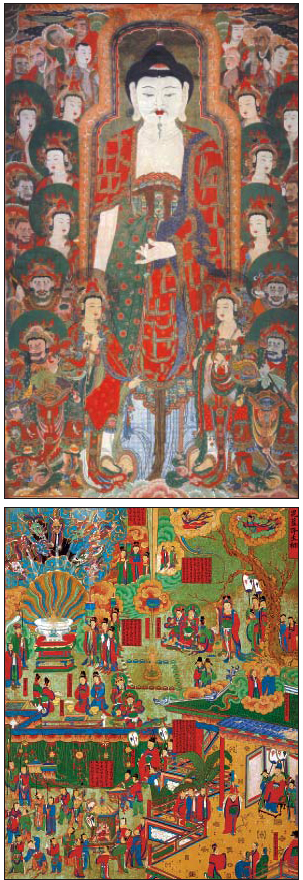Buddhist masterpieces on display for holiday

Top: The original painting of the “Buddhist Hanging Scroll at Bukjangsa Temple” is currently on display in the Buddhist Painting Hall of the National Museum of Korea for “The Buddha Listens to Prayers” exhibition. Above: “Birth at Lumbini” is the second scene of “The Eight Scenes of Buddha’s Life,” a series of large paintings depicting the life of the Shakyamuni Buddha on display at the Hoam Art Museum. [NATIONAL MUSEUM OF KOREA, HOAM ART MUSEUM]
As the monk anticipated, it rained the next day, providing an appropriate kick-off to the exhibition titled “The Buddha Listens to Prayers” at the National Museum to celebrate the upcoming Buddha’s Birthday holiday on Saturday.
For the exhibition, which lasts through Nov. 6, the National Museum brought in the original “Buddhist Hanging Scroll at Bukjangsa Temple,” which is 13 meters (43 feet) in height and 8 meters in width. Because the height of the wall is about a meter shorter than the scroll, the bottom edge of the painting could not be rolled out; however, the entire painting can be viewed from top to bottom.
Owned by Bukjang Temple in North Gyeongsang, the scroll painting that is presumed to have been completed in 1688 is designated as Treasure No. 1,278.
According to Yoo Kyung-hee, a researcher at the National Museum, this hanging painting is significant, as the Buddha at the center who is praying is portrayed standing up.
“Other Buddhist hanging paintings depict the Buddha sitting down. It is usual to have Buddha sitting down as they pray,” Yoo said. “But for this painting, it’s said that the monk painters wanted to portray this Buddha like a messiah.”
The exhibition displays more Buddhist paintings of other Buddhas who listen to different prayers for curing diseases, going to paradise after death, conceiving a child and so on.
Meanwhile, at the Hoam Art Museum in Yongin, Gyeonggi, an exhibition titled “Three Jewels: Buddhist Art of Korea” kicked off last month to also give visitors a chance to be immersed in the beauty of Korean Buddhist paintings to celebrate Buddha’s Birthday.
This exhibition, which also runs until Nov. 6, showcases about 40 pieces of ancient Korean paintings, sculptures, documents and artifacts related to Buddhism, such as “The Eight Scenes of Buddha’s Life,” a series of paintings from the Joseon Dynasty (1392-1910).
The exhibition is divided into three sections, according to the museum, to showcase the characteristics and significance of Korea’s Buddhist art.
The first section will give visitors a tour of the “World of Buddha.” Two important Buddhas appear in this section - Shakyamuni, also known as Siddhartha Gautama, and Amitabha. This is where visitors can see the large paintings of “The Eight Scenes of Buddha’s Life,” which depict the Shakyamuni Buddha’s lifetime across eight different scenes.
The second section will allow visitors to learn about the “Teachings of the Buddha.” According to the museum, the teachings of the Shakyamuni Buddha were handed down by tradition but eventually were recorded as text. Diverse Buddhist scriptures can be witnessed in this section.
The third section features various objects used for Buddhist ceremonies.
BY YIM SEUNG-HYE [sharon@joongang.co.kr]










with the Korea JoongAng Daily
To write comments, please log in to one of the accounts.
Standards Board Policy (0/250자)